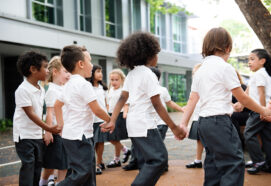One of the greatest challenges in my experience of working psychotherapeutically in schools has been in trying to balance the increasing complexity of children’s mental health needs with the reduction in funding and therefore time frame in which to work. An estimated one in eight (12.8%) children and young people aged between five and 19 has a diagnosable mental health condition, yet only a quarter (25.2%) of those have had contact with mental health specialists.1 In addition to those with a diagnosable mental health condition are those struggling with social and emotional difficulties which do not reach the threshold of a diagnosis. Concerns about these unmet mental health needs of young people have heightened in the midst of the COVID-19 pandemic. The University of Oxford’s Co-Space Study,2 for example, recently reported a 35% increase in primary school children likely to have significant emotional, behavioural or restlessness/inattention difficulties during lockdown. As children spend such a substantial amount of time in school (approximately a third of the day), it often falls to school staff to address the gap in social, emotional and mental health provision. But this is not without its challenges.
It is well known that school budgets are increasingly stretched and that they too have to balance the educational needs of children with the resources available to them for children’s wellbeing. This constraint has often meant that therapeutic work in schools has needed to be brief or short term, so that the needs can be balanced by the capacity. Although it is true that there are those children and families who benefit greatly from a short period of therapeutic support, the majority of children referred to me have needed a substantial amount of time to build trust and connection with me in order to risk relinquishing their strongly held but frequently unhelpful ways of trying to manage their anxieties, which often lead to counterproductive or destructive behaviours. But as is the case in all things, there has to be a negotiation. In order to circumnavigate the briefer period of work, I have chosen in my career to focus much more on scaffolding the people who matter most in the child’s world, namely parents and school staff. This work aims to strengthen relationships around the child, creating a stronger, more reflective environment for change.
In my experience, because of the time spent with and connection with teachers, children often seem to project into teachers parts of themselves which they cannot tolerate (such as intense fear or not feeling ‘good enough’). This powerful and largely unconscious mechanism is called projective identification3 and can be highly disruptive to child-teacher relationships if such ‘coping mechanisms’ are unacknowledged and uncontained. A child I worked with recently had a history of experiencing frightening domestic violence episodes in his family and would often erupt suddenly in lessons by kicking over chairs or attacking his peers. In a consultation with his learning mentor, she reported feelings of intense fear and inadequacy, stating that it was like ‘holding back a wild animal with a matchstick’. This made her feel deeply resentful and angry towards both the boy and her own colleagues for putting her in that situation. Through consultation with me, she was able to acknowledge the strong feelings of fear and inadequacy that seemed to be projected from the child. When it became possible to think about what had been largely unconscious she was able to feel more connected and therefore compassionate towards him. Their relationship grew and he was more able to verbalise his feelings to her, rather than act them out through aggression.
I’ve also seen that strong projections can originate from family members which have an equally profound impact on teachers (and therefore their emotional availability to work with children). Due to their stability, routine and availability, schools can often become the ‘secure bases’ for our vulnerable families who are yet to have a good enough experience of a thoughtful or nurturing mind. Equally schools can become the ‘prying eye’s’ or authoritarians for those who have experienced imbalances in power or trust. Either way, strong projections from parents can stir up feelings in teachers which can profoundly impact on their capacity to think about the children, to become defensive or even strongly critical of others in an effort to be relieved of what is projected into them. The psychoanalytical role here is in helping teachers to become aware of these unconscious projections and use them to help develop a deeper understanding of the feelings and dynamics around the child and therefore what strategies might be helpful in order to support the child and family.
But the work outlined above requires a great degree of willingness and trust from teachers, to engage with what might feel like an exposing or vulnerable consultation with a Child and Adolescent Psychotherapist. One of our challenges is balancing the need to explore teachers’ connections with children and families whilst at the same time acknowledging their need to keep hold of their own necessary defences which enable them to withstand being on the forefront of the enormity of social, emotional and mental health needs in schools at this time.
References
1 Sadler, K. et al. (2018) Mental Health of Children and Young People in England, 2017: Summary of key findings. NHS Digital: https://digital.nhs.uk/data-and-information/publications/statistical/mental-health-of-children-and-young-people-in-england/2017/2017.
2 Pearcey, S. et al. (2020). Report 05: Changes in children and young people’s mental health symptoms and ‘caseness’ during lockdown and patterns associated with key demographic factors. CoSPACE Study: https://cospaceoxford.org/findings/changes-in-children-mental-health-symptoms-september-2020/.
3 Klein, M. (1946). Notes on Some Schizoid Mechanisms. Int. J. Psycho-Anal., 27:99-110.



Discussion
Thank you for a very insightful and in- depth view.
A very interesting and thoughtful perspective , thank you.
Woe, such a very interesting and thoughtful perspective , thank you so much!!! Really enjoyed reading it today!!!!
Really insightful & non judgemental account of the interplay between psychotherapy, young people, their families, teaching staff & schools. I enjoyed reading it & many thanks.
Your reflections and narratives of the interplay between psychotherapy, children and families, teachers and school , have given me hope. I am a retired Education professional and am horrified at the treatment given to my eldest Grandchild by her school and the allocated Education Psychologist. My daughter has had to withdraw her daughter from school because of the increasing ostracization and isolation at the age of seven her daughter is experiencing. However, as you say, funding is an issue and there will be many children who will be failed .
This is so true. I am provilaged to be working with some fantastic organisations who support in this sector and the difficulties they face. Thanks for sharing